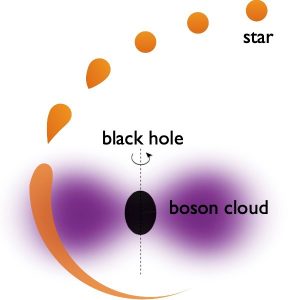Study Sheds New Light on the Nature of Dark Matter
In a recently published study, Drs. Rosalba Perna, Rouven Essig, Peizhi Du, and collaborators propose a new way to search for novel particles not contained in the current standard model of particle physics.
 Image courtesy of Peizhi Du. A star (orange) that gets close to a supermassive black
hole (black) can be tidally disrupted by the black hole’s strong gravitational pull.
According to a new study, if ultra-light bosons exist (purple), they can affect the
spin of the black hole, which in turn affects the rate at which tidal disruption events
occur.
Image courtesy of Peizhi Du. A star (orange) that gets close to a supermassive black
hole (black) can be tidally disrupted by the black hole’s strong gravitational pull.
According to a new study, if ultra-light bosons exist (purple), they can affect the
spin of the black hole, which in turn affects the rate at which tidal disruption events
occur.
Stars passing close to the supermassive black hole found in the center of galaxies are disrupted by tidal forces. These disruptions cause flares that can be observed as bright transient events.
The rate at which these events occur depends on the spin of the black hole, which can be affected by ultra-light bosons surrounding it.
"The potential implications of our findings are profound. The discovery of new ultra-light bosons in stellar tidal disruption surveys would be revolutionary for fundamental physics"
- Dr. Essig
The team demonstrated that, due to the dependence of the tidal disruption rates on the black hole spin and the connection between the spin and the ultra-light bosons, measurements of the stellar disruption rates could be used to discover or rule out a variety of ultra-light boson models.
The results from the new method could help illuminate the nature of dark matter.
"These new particles could be the dark matter, and thus the work could open up windows into a complex dark sector that hints toward more fundamental descriptions of nature such as string theory."
- Dr. Perna
The article, published in Nature Communications, may be viewed here. A university news article highlighting the achievement may be read here.
